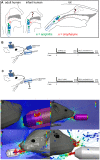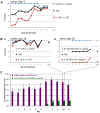Direct behavioral evidence for retronasal olfaction in rats
- PMID: 22970305
- PMCID: PMC3435269
- DOI: 10.1371/journal.pone.0044781
Direct behavioral evidence for retronasal olfaction in rats
Abstract
The neuroscience of flavor perception is becoming increasingly important to understand abnormal feeding behaviors and associated chronic diseases such as obesity. Yet, flavor research has mainly depended on human subjects due to the lack of an animal model. A crucial step towards establishing an animal model of flavor research is to determine whether the animal uses the retronasal mode of olfaction, an essential element of flavor perception. We designed a go- no go behavioral task to test the rat's ability to detect and discriminate retronasal odorants. In this paradigm, tasteless aqueous solutions of odorants were licked by water-restricted head-fixed rats from a lick spout. Orthonasal contamination was avoided by employing a combination of a vacuum around the lick-spout and blowing clean air toward the nose. Flow models support the effectiveness of both approaches. The licked odorants were successfully discriminated by rats. Moreover, the tasteless odorant amyl acetate was reliably discriminated against pure distilled water in a concentration-dependent manner. The results from this retronasal odor discrimination task suggest that rats are capable of smelling retronasally. This direct behavioral evidence establishes the rat as a useful animal model for flavor research.
Conflict of interest statement
Figures





Similar articles
-
Direct behavioral and neurophysiological evidence for retronasal olfaction in mice.PLoS One. 2015 Feb 12;10(2):e0117218. doi: 10.1371/journal.pone.0117218. eCollection 2015. PLoS One. 2015. PMID: 25675095 Free PMC article.
-
Retronasal odor representations in the dorsal olfactory bulb of rats.J Neurosci. 2012 Jun 6;32(23):7949-59. doi: 10.1523/JNEUROSCI.1413-12.2012. J Neurosci. 2012. PMID: 22674270 Free PMC article.
-
Transfer of Odor Perception From the Retronasal to the Orthonasal Pathway.Chem Senses. 2021 Jan 1;46:bjaa074. doi: 10.1093/chemse/bjaa074. Chem Senses. 2021. PMID: 33196792 Free PMC article.
-
Factors affecting the ortho- and retronasal perception of flavors: A review.Crit Rev Food Sci Nutr. 2018 Apr 13;58(6):913-923. doi: 10.1080/10408398.2016.1231167. Epub 2017 Jul 5. Crit Rev Food Sci Nutr. 2018. PMID: 27646486 Review.
-
Retronasal Olfaction Test Methods: A Systematic Review.Balkan Med J. 2019 Jan 1;36(1):49-59. doi: 10.4274/balkanmedj.2018.0052. Epub 2018 Sep 28. Balkan Med J. 2019. PMID: 30264731 Free PMC article.
Cited by
-
Direct behavioral and neurophysiological evidence for retronasal olfaction in mice.PLoS One. 2015 Feb 12;10(2):e0117218. doi: 10.1371/journal.pone.0117218. eCollection 2015. PLoS One. 2015. PMID: 25675095 Free PMC article.
-
Odor modality is transmitted to cortical brain regions from the olfactory bulb.J Neurophysiol. 2023 Nov 1;130(5):1226-1242. doi: 10.1152/jn.00101.2023. Epub 2023 Oct 4. J Neurophysiol. 2023. PMID: 37791383 Free PMC article.
-
A role for lung retention in the sense of retronasal smell.Chemosens Percept. 2015 Aug 1;8(2):78-84. doi: 10.1007/s12078-015-9181-z. Epub 2015 May 10. Chemosens Percept. 2015. PMID: 26557213 Free PMC article.
-
Identification of odorant-receptor interactions by global mapping of the human odorome.PLoS One. 2014 Apr 2;9(4):e93037. doi: 10.1371/journal.pone.0093037. eCollection 2014. PLoS One. 2014. PMID: 24695519 Free PMC article.
-
Retronasal Odor Perception Requires Taste Cortex, but Orthonasal Does Not.Curr Biol. 2019 Jan 7;29(1):62-69.e3. doi: 10.1016/j.cub.2018.11.011. Epub 2018 Dec 20. Curr Biol. 2019. PMID: 30581018 Free PMC article.
References
-
- Duffy VB (2007) Variation in oral sensation: implications for diet and health. Current Opinion in Gastroenterology 23: 171–177. - PubMed
-
- Small DM, Prescott J (2005) Odor/taste integration and the perception of flavor. Exp Br Res 166: 345–357. - PubMed
-
- Rozin P (1982) “Taste-smell confusions” and the duality of the olfactory sense. Percept & Psychophys 31: 397–401. - PubMed
-
- Murphy C, Cain WS (1980) Taste and olfaction: independence vs interaction. Physiol & Behav 24: 601–605. - PubMed
Publication types
MeSH terms
Grants and funding
LinkOut - more resources
Full Text Sources

